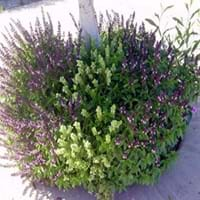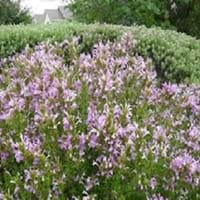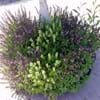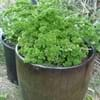Life Span
Perennial
Perennial
Origin
Middle Africa, Southern Africa, Southern Asia, Southeastern Asia
Southwestern United States, Mexico, Central America, South America
Types
Not Available
Mexican oregano,Mediterranean oregano
Habitat
Not Available
Stony hillsides
USDA Hardiness Zone
9-11
10-12
Sunset Zone
A1, A2, A3, H1, H2, 1a, 1b, 2a, 2b, 3a, 3b, 4, 5, 6, 7, 8, 9, 10, 11, 12, 13, 14, 15, 16, 17, 18, 19, 20, 21, 22, 23, 24
8, 9, 10, 11, 12, 13, 19, 20, 21, 22, 23, 24
Habit
Clump-Forming
Arching/Fountain-shaped
Flower Color
Pink, Lavender
White, Light Yellow
Flower Color Modifier
Bicolor
Bicolor
Leaf Color in Spring
Green
Green, Dark Green
Leaf Color in Summer
Green
Green, Dark Green
Leaf Color in Fall
Green
Green, Dark Green
Leaf Color in Winter
Light Green
Light Green
Leaf Shape
Oval
Spade shaped
Plant Season
Spring, Summer, Fall, Winter
Spring, Summer, Fall, Winter
Sunlight
Full Sun
Full Sun, Partial Sun
Growth Rate
Very Fast
Medium
Type of Soil
Loam, Sand
Loam, Sand
The pH of Soil
Neutral
Neutral, Alkaline
Soil Drainage
Well drained
Well drained
Bloom Time
Indeterminate
Spring, Summer, Early Fall, Fall
Tolerances
Drought
Drought
Where to Plant?
Container, Ground, Pot
Container, Ground
How to Plant?
Transplanting
Seedlings, Stem Cutting
Plant Maintenance
Medium
Medium
Watering Requirements
Requires watering in the growing season, Water Deeply
Requires regular watering
In Summer
Lots of watering
Lots of watering
In Spring
Moderate
Moderate
In Winter
Average Water
Average Water
Soil pH
Neutral
Neutral, Alkaline
Soil Type
Loam, Sand
Loam, Sand
Soil Drainage Capacity
Well drained
Well drained
Sun Exposure
Full Sun
Full Sun, Partial Sun
Pruning
Don't prune in the fall, Prune regularly
Remove damaged leaves, Remove dead branches, Remove dead leaves
Fertilizers
All-Purpose Liquid Fertilizer
All-Purpose Liquid Fertilizer
Pests and Diseases
Red blotch
Red blotch
Plant Tolerance
Drought
Drought
Flower Petal Number
Single
Single
Fragrant Bark/Stem
Yes
Yes
Foliage Texture
Medium
Medium
Foliage Sheen
Not Available
Matte
Attracts
Not Available
Bees, Butterflies
Allergy
Respiratory problems, Runny nose, Skin rash, Vomiting
Avoid during Pregnancy
Aesthetic Uses
Showy Purposes
Showy Purposes
Beauty Benefits
Not Available
Not Available
Environmental Uses
Air purification
Air purification
Medicinal Uses
Cough, Cramps, Digestive disorders, Insomnia, Skin Disorders, Vomiting
Antihydrotic, Antiseptic, Antispasmodic, Astringent
Part of Plant Used
Leaves
Leaves, Seeds
Other Uses
Air freshner, Can be made into a herbal tea, Used As Food, Used as a spice
For making oil
Used As Indoor Plant
Yes
Yes
Used As Outdoor Plant
Yes
Yes
Garden Design
Container, Edible, Herb / Vegetable, Mixed Border
Container, Edible, Herb / Vegetable, Mixed Border
Botanical Name
OCIMUM basilicum 'Cinnamon'
LIPPIA graveolens
Common Name
Basil, Cinnamon Basil
Mexican Oregano
In Hindi
सिनेमन तुलसी
Lippia graveolens
In German
Zimt-Basilikum
Mexikanischer Oregano
In French
cannelle basilic
Lippia graveolens
In Spanish
Ocimum basilicum
Lippia graveolens
In Greek
βασιλικός
Lippia graveolens
In Portuguese
Manjericão-de-folha-larga
Lippia graveolens
In Polish
Bazylia pospolita
Lippia graveolens
In Latin
Basilius
Lippia graveolens
Phylum
Tracheophyta
Tracheophyta
Class
Magnoliopsida
Magnoliopsida
Family
Lamiaceae
Verbenaceae
Clade
Asterids
Angiosperms, Asterids, Eudicots
Tribe
Not Available
Not Available
Subfamily
Not Available
Not Available
Number of Species
Not Available
Not Available
Properties of Cinnamon Basil and Mexican Oregano
Wondering what are the properties of Cinnamon Basil and Mexican Oregano? We provide you with everything About Cinnamon Basil and Mexican Oregano. Cinnamon Basil doesn't have thorns and Mexican Oregano doesn't have thorns. Also Cinnamon Basil does not have fragrant flowers. Cinnamon Basil has allergic reactions like Respiratory problems, Runny nose, Skin rash and Vomiting and Mexican Oregano has allergic reactions like Respiratory problems, Runny nose, Skin rash and Vomiting. Compare all the properties and characteristics of these two plants. Find out which of these plant can be used as indoor plant. If you are interested to decorate your house and garden, find out aesthetic uses, compare them and select the plant which will beautify your surrounding. Along with beautification, try comparing medicinal and edible uses of Cinnamon Basil and Mexican Oregano and you can choose the plant having best and most benefits.
Season and Care of Cinnamon Basil and Mexican Oregano
Season and care of Cinnamon Basil and Mexican Oregano is important to know. While considering everything about Cinnamon Basil and Mexican Oregano Care, growing season is an essential factor. Cinnamon Basil season is Spring, Summer, Fall and Winter and Mexican Oregano season is Spring, Summer, Fall and Winter. The type of soil for Cinnamon Basil is Loam, Sand and for Mexican Oregano is Loam, Sand while the PH of soil for Cinnamon Basil is Neutral and for Mexican Oregano is Neutral, Alkaline.
Cinnamon Basil and Mexican Oregano Physical Information
Cinnamon Basil and Mexican Oregano physical information is very important for comparison. Cinnamon Basil height is 35.50 cm and width 25.40 cm whereas Mexican Oregano height is 90.00 cm and width 90.00 cm. The color specification of Cinnamon Basil and Mexican Oregano are as follows:
Cinnamon Basil flower color: Pink and Lavender
Cinnamon Basil leaf color: Green
Mexican Oregano flower color: White and Light Yellow
- Mexican Oregano leaf color: Green and Dark Green
Care of Cinnamon Basil and Mexican Oregano
Care of Cinnamon Basil and Mexican Oregano include pruning, fertilizers, watering etc. Cinnamon Basil pruning is done Don't prune in the fall and Prune regularly and Mexican Oregano pruning is done Remove damaged leaves, Remove dead branches and Remove dead leaves. In summer Cinnamon Basil needs Lots of watering and in winter, it needs Average Water. Whereas, in summer Mexican Oregano needs Lots of watering and in winter, it needs Average Water.





